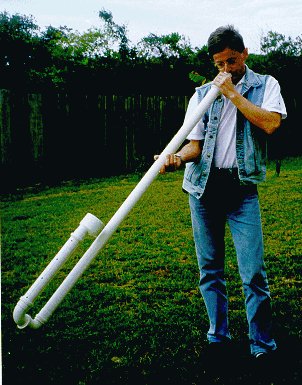For somebody who would like to try to find out what playing didjeridu feels like without spending lots of money, a piece of PVC tube (1,25 m of 40mm tube should give a D) can be an interesting option, of course. Some time ago, I used PVC pipes in the keys of C or D for the didjeridu lessons I'm giving. This lets you play unisono with your students, and avoids distracting their attention from the player's factors (mouth and lip positions, breathing etc.). Previously, I'd found that many students were prone to using the instrument as an excuse when we all played on (different) eucalyptus didjeridus.
Lately, I've been using aluminum tubes for that purpose. The emotionally important factors (look, feel, smell) of this material are a lot more satisfactory, and even the sound is a bit better (still a perfectly regular tube, that rings out all the time and has no personal character). In all senses, though, nothing compares to the real thing...
Ok, this being said, here are some of the low ones.
The playing style of all of them is quite unique: hard to get the initial burst for the low vibration. You have to loosen your lips incredibly. One can almost count the flaps of one's lips... High vocals get through almost too easily, always threatening to stop the drone, as the basic vibration is quite slow and needs a lot of streaming air. Low vocals or growls are not very feasible, because they would be too close to the basic key. Gut slaps and rhythms also tend to stop the drone easily. On the other hand, there are lots of toots (up to 5), of which the first one sounds completely like another drone and the first two or three are still playable continuously (circular breathing).
 This one is playing in a low F; the U-shaped form is interesting, as the
player gets a bit more of the sound. It is around 8ft of 50mm tube.
This one is playing in a low F; the U-shaped form is interesting, as the
player gets a bit more of the sound. It is around 8ft of 50mm tube.
 The second is an interesting variation of a snake didje, made of almost 10ft
of 50mm tube altogether . The mouthpiece is a 90 degree knee of 40mm. This allows you to
play it almost like a baritone sax. Its key is a low C#! The sound is rather
weak, due to the many bends. It is relatively hard to get the drone
going... But it is rather handy to carry around for a low didje.
The second is an interesting variation of a snake didje, made of almost 10ft
of 50mm tube altogether . The mouthpiece is a 90 degree knee of 40mm. This allows you to
play it almost like a baritone sax. Its key is a low C#! The sound is rather
weak, due to the many bends. It is relatively hard to get the drone
going... But it is rather handy to carry around for a low didje.
 The last one here is made of 7ft of 50mm tube and 3ft of 75mm. It plays also in a
low F (like the U-shaped above), but, compared to the first, it has a ten times more powerful sound!
It is really incredible. If you play that one inside a closed room, the windows start to
swing in such a way that you get afraid they might burst at any moment. The floor, ceiling and
walls start to tremble, the most amazing experience I ever had on a low
didge. Not easy to get it going and it demands a lot of air, but what a
sound!
The last one here is made of 7ft of 50mm tube and 3ft of 75mm. It plays also in a
low F (like the U-shaped above), but, compared to the first, it has a ten times more powerful sound!
It is really incredible. If you play that one inside a closed room, the windows start to
swing in such a way that you get afraid they might burst at any moment. The floor, ceiling and
walls start to tremble, the most amazing experience I ever had on a low
didge. Not easy to get it going and it demands a lot of air, but what a
sound!
